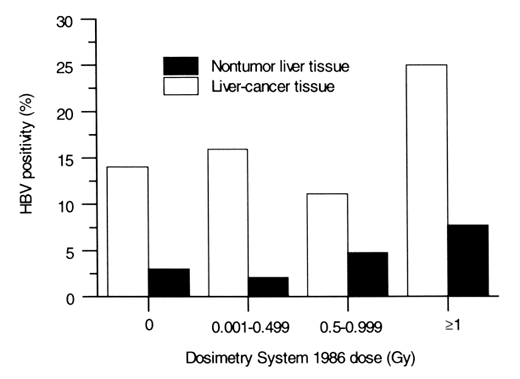Investigating the Link between Liver Cancer and Hepatitis
Because hepatitis B and C infections are closely associated with hepatocellular carcinoma in Japan, RERF researchers are scrutinizing these viruses at the DNA level in cancerous and noncancerous liver tissue from atomic-bomb survivors.
by Terumi Mizuno, Toshio Seyama, and Mitoshi Akiyama, Department of Radiobiology, RERF
This article was originally published in RERF Update 6(3):6-7, 1994.
Several kinds of cancer occur with greater frequency among atomic-bomb (A-bomb) survivors than in the general Japanese population. The complexities of cancer development involve multiple stages, and researchers at RERF are investigating how radiation enters into this complicated picture. One way to tackle this perplexing problem is through a detailed analysis of various gene alterations that likely exist in tumors as characteristic DNA lesions left by ionizing radiation.
Why investigate the link between liver cancer and the hepatitis viruses?
Recently, Thompson et al reported a significant radiation dose response for primary liver cancer (PLC) among members of RERF’s Life Span Study (Radiation Research 137:S17-S67, 1994). Etiological factors in liver-cancer development include the hepatitis B virus (HBV) and hepatitis C virus (HCV), alcohol consumption, and aflatoxin B1 exposure (Harris, Cancer Cells 2:146-148, 1990). In Japan, epidemiological studies suggest that more than 70% of PLC is caused by HBV and HCV infection. Thus, the frequency of viral infection cannot be ignored when investigating the role of A-bomb radiation in hepatocellular carcinoma (HCC). The analysis of these viruses in liver cancers among A-bomb survivors may give some insight concerning the role of radiation in the increased risk of liver cancers in the A-bomb survivors.
RERF researchers have long had an interest in the relationship between radiation exposure and liver cancer. Reporting here on only one aspect of this work, we analyzed the frequency of HBV infection in liver tissue using molecular biology techniques. Furthermore, we investigated how HBV participates in liver-cancer development and what relationship exists between HBV infection and other gene changes, such as oncogene activation and tumor-suppressor gene inactivation–the two types of events that are believed to be central to carcinogenesis.
Recently, it was shown that one of the HBV products, the HBX protein, can interact with the p53 gene product, suppressing its function (Wang, Proceedings of the National Academy of Sciences 91:2230-4, 1994). A similar action occurs in cervical cancer in which human papilloma viruses inactivate the p53 gene function (Dyson, Science 243:934-7, 1989). Thus, the role of HBV in hepatocarcinogenesis may be via p53 inactivation. The analytical method we used is the polymerase chain reaction (PCR) using DNA extracted from paraffin-embedded cancerous and noncancerous liver tissues. HBV is a 3.2-kilobase-pair DNA virus and the functional three domains–the S, pre-C, and X regions–were amplified by PCR. We examined 237 PLC tissue samples and 396 control nontumor liver-tissue samples. Amplification was successful in about 80% of the extracted DNA.
HBV found in genomic DNA more often among liver-cancer tissues
When PLC tissues and control tissues were compared, the HBV infection frequency was higher in the PLC group (16%) than in the control group (3%)–a statistically significant difference (see Table below). These findings suggest that HBV infection in liver cells is etiologically involved in human HCC and that one or more genetic events is needed to accomplish liver cell transformation to malignancy.
Table. Frequency of hepatitis B virus infection in cases of
hepatocellular carcinoma (HCC)and in control cases by city and sex.
|
|||||||||||||||||||||||||||||||||||||||||||||||||||||||||||||||||||||||||||
|
|||||||||||||||||||||||||||||||||||||||||||||||||||||||||||||||||||||||||||
Among PLC patients, the frequency of HBV infections differed little between tumors and nearby normal liver tissue; ie, when tumor tissue was HBV-infected, the surrounding normal tissue was also infected, and vice versa. Similarly, we found no clear differences by city of residence or sex.
Previously, Asano et al reported that hepatitis B surface (HBs) antigen positivity was twice as high in Nagasaki as in Hiroshima among city- and age-ATB-matched patients who did not have overt liver disease (Journal of National Cancer of Institute 69:1221-7, 1982).
The discrepancy between our findings and those of Asano et al might be attributed somehow to the fact that we examined the frequency of actual integration of viral genome in the genomic DNA of the liver cells rather than the existence of antibody in the serum.
Radiation exposure and HBV infection
What role, if any, radiation dose plays in susceptibility to infection by HBV remains unclear. Though there appears to be a trend, the correlation between HBV infection and A-bomb radiation does not reach statistical significance. Analysis of more cases from among the highly exposed survivors might strengthen this observed correlation.

Figure. Frequency of hepatitis B virus (HBV) infection by Dosimetry System 1986 dose estimates.
Akiyama et al have observed a dose-dependent higher titer of Epstein-Barr virus (EBV) antibody among survivors (Radiation Research 133:297-302, 1993), possibly indicating that more frequent viral infections among survivors may result from reduced immunological competence caused by A-bomb radiation.
HCV genome detected in preserved tissue for the first time
Recently, using reverse transcription-PCR (RT-PCR) in paraffin-embedded liver tissues, we succeeded in detecting the HCV genome, whose molecular analysis in preserved tissues has long eluded researchers.
In the Radiobiology Department, during the next phase of our liver-cancer work, we will try to discern the frequency of HCV genomic material detectable in normal and cancerous hepatic tissues from A-bomb survivors.
Currently, in RERF’s Department of Clinical Studies, a serological study of HCV among Adult Health Study participants is also being conducted.
From the standpoint of molecular epidemiology and molecular oncology, understanding the interactions of viral infection, oncogenes, and tumor-suppressor genes may bring into better focus the full picture of radiation-induced hepatocarcinogenesis.

